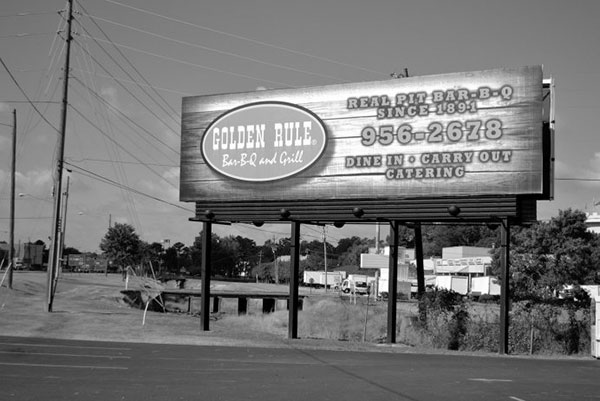
Golden Rule Bar-B-Q in Irondale now has a prime location immediately off I-20. Author’s collection.
CHAPTER 4
DIRT FLOORS AND ROADSIDE SHACKS
The Origins of Alabama Barbecue Restaurants, 1890s–1930s
Around the turn of the twentieth century, Americans moved from the countryside into the city to pursue job opportunities. Among them, African Americans left the farms to seek better lives in the city. At the same time, immigrants poured into the United States and settled in these growing cities as well. By the 1920s, most Americans lived in urban areas. They worked in America’s factories, either on the assembly line or as clerks or supervisors, and at other jobs in middle management.102
At the same time, Americans fell in love with the automobile. They traveled more often and greater distances for work and leisure. They took advantage of new paved highways to visit previously far-away destinations.103
Americans changed their eating habits because of industrialization, urbanization and the invention of the automobile. In previous decades and centuries, restaurateurs catered to the urban elite, who had the disposable income for lavish meals. In each city, wealthy diners only had a few options. After moving from the farm to the city, most Americans now purchased their food rather than cultivating crops or raising livestock. Removed from the dining room table throughout the day, urban workers and highway travelers needed new places to eat their meals. For these reasons, urban residents, workers and travelers generated a concentrated and consistent demand for cheap, quick food. At the turn of the century, restaurateurs opened up cafés, lunchrooms and other quick-service eateries.104
In the early twentieth century, barbecue moved from the public picnic table to the restaurant. Throughout the country, barbecue’s popularity and ability to efficiently feed large numbers of people made it a promising business opportunity. In Alabama and elsewhere, barbecue restaurateurs opened stands, shacks and eventually full-service restaurants near urban centers. On highways, gas station managers sometimes sold barbecue in this same manner. Or entrepreneurs sold barbecue out of their homes. These original pit masters only used their barbecue skills to supplement income from another job. They cooked barbecue on Thursdays or Fridays and sold the meat until it ran out; then they repeated the process the following week. Locations on major roads fed travelers; those in urban centers served blue-collar workers, mostly men. If successful, these pit masters sometimes quit their regular jobs and made the barbecue business a full-time endeavor.105
Due to the demands of profit, most restaurateurs had to choose simple menus to avoid spoilage and save money, and their decisions led to the regionalization of barbecue. Before the restaurant industry, barbecues consisted of whatever meats the local farmers had to offer. People brought side dishes and desserts based on the ingredients they had on hand and could afford to spare. Restaurateurs, however, had to choose locally available meats that they could sell customers before spoilage took over. In Texas, barbecue restaurateurs chose beef. In North Carolina, they chose pork. In Alabama, they mostly focused on pork and chicken.106
GOLDEN RULE BAR-B-Q
The Williams Years of Golden Rule Bar-B-Q
In 1891, the Williams family from Gadsden opened Golden-Rule Bar-B-Q in Irondale, an industrial town outside Birmingham, where Alabamians produced weapons for the Confederacy during the Civil War.107 At the time of Golden Rule Bar-B-Q’s founding, the restaurant sat on a dirt road, but this road eventually became U.S. 78, which served as the major route for travelers between Birmingham and Atlanta.108
For more than eighty years, the Williams family operated Golden Rule Bar-B-Q. Until the 1970s, Ellene Williams Stone and Ella Ruth Hutchings Mize managed the restaurant. Ruth’s husband, Shorty, worked as a pit man. Ellene’s husband, Jabo, worked as an electrician at his family’s business, the Stone Electric Company.109 Although Jabo continued to work as an electrician after marrying Ellene, he pitched in to help at the restaurant on the busiest days. As an owner of the restaurant, he also negotiated the sale of the restaurant in later years.110

Golden Rule Bar-B-Q in Irondale now has a prime location immediately off I-20. Author’s collection.
For most of the twentieth century, Golden Rule Bar-B-Q served breakfast and barbecue pork plates, hamburgers, hamburger steaks, hot dogs, French fries and salads but also cigarettes and beer. Sometimes, they also repaired automobiles.111 Under the ownership of the Williams family, Golden Rule Bar-B-Q did a lot of business in barbecue but especially in beer. For many years, travelers had to purchase alcohol in Irondale because only dry counties lay between them and Atlanta. People on the outskirts of the city had to come to Irondale to imbibe.112
Golden Rule Bar-B-Q earned a reputation in Birmingham for excellent food. As a young man, Michael Matsos, who eventually owned numerous restaurants and hotels in Birmingham, including Golden Rule Bar-B-Q, had visited the restaurant as a patron and eaten the barbecue sandwich. “I used to go to the Golden Rule,” said Matsos. He recalled gathering with friends “just to get some good barbecue.” He added, “I loved their barbecue sandwich the way he [Shorty Mize] did it and everything and the sauce.”113
Until the 1960s, Golden Rule Bar-B-Q had a segregated dining room, as required by Alabama state law. When Matsos visited the restaurant as a young customer, he remembered the presence of segregation. He explained, “They had a separate dining room in the back for the blacks with their own jukebox.” He added, “I wasn’t used to that, being from up North.”114 In 1964, however, the U.S. Congress passed the Civil Rights Act of 1964, which outlawed segregation in public establishments.
In 1971, Ellene and Jabo Stone wanted to retire, and they sold the restaurant to Matsos and partner Tommy Stevens. The Stones knew Matsos because of his success in the Birmingham area as a restaurateur. “I think he saw how we were doing at Michael’s downtown, and he used to come over there and hang around there,” explained Matsos, referring to Jabo Stone.115
When Stone sold the business, he did not want any money down but instead wanted royalties. In the sale contract, Stone required Matsos to open another location as part of the deal. “Jabo Stone got the best of me,” admitted Matsos. “I think he outsmarted me. I think he made lots more money in twenty years than what he would have got with a cash offer upfront.”116 Under the ownership of Matsos, Golden Rule Bar-B-Q spread throughout the state.
Michael Matsos: An Alabama Restaurant Legend
Born in 1918 in New Bedford, Massachusetts, to Greek immigrants, Matsos lived most of his early life in Brooklyn, New York. Toward the end of the Great Depression, Matsos packed his bags and relocated to Tuscaloosa, where he enrolled in the University of Alabama. “I realized that the University of Alabama Commerce School, at the time, with Dean Bidgood, was the best buy for the money,” explained Matsos. He excelled at the university, but his career in business would have to wait a few years.117
In 1941, the United States entered World War II. Upon graduation, Matsos recalled, “I got a degree in one hand and a report to Fort Benning in the other.” During the war, he enlisted in the U.S. Army Air Corps from Alabama, part of the Fifteenth Air Force in Italy. After the war, he worked as an air traffic controller in Atlanta, Georgia. In 1947, he returned to the Birmingham area, where he entered the restaurant business.118
In 1948, Matsos partnered with Greek chef Bill Demoes to open La Paree, which served steaks, seafood and Greek fare to Birmingham’s upscale residents and visitors. They opened the restaurant on Fifth Avenue North near the Tutwiler Hotel, where Matsos attracted lots of customers. He offered free meals to the Tutwiler Hotel’s doorman to persuade him to direct hotel guests toward La Paree.119
In 1953, Matsos sold his share of the restaurant to Demoes and opened Michael’s Sirloin Room in the Holiday Inn in Bessemer, but he soon opened other locations of this restaurant throughout the state. At Michael’s Sirloin Room, Matsos served customers many of the same recipes that he had served at La Paree. Later in the 1950s, Matsos opened new locations in the Holiday Inn in Huntsville and the Ramada Inn in Madison. In 1958, Matsos opened another location in the Southside neighborhood of Birmingham near Legion Field. Due to this location’s proximity to the stadium, it became a huge success. At this location, Matsos’s restaurant hosted many celebrities, including Alabama football coach Paul “Bear” Bryant.120
At Michael’s Sirloin Room, Matsos partnered with some of Birmingham’s future chefs and restaurateurs, thus making an imprint on Birmingham food that has continued after his death. In addition to the restaurants, Matsos owned Birmingham’s Hyatt Regency, where Frank Stitt worked as a beverage director. Stitt has become an internationally famous chef and winner of numerous James Beard Foundation Awards. He now operates Highlands Bar and Grill, among other Birmingham favorites, such as Chez Fonfon, Bottega and Bottega Café.121
Two Greek men who have partnered with Matsos have gone on to own and operate some of Birmingham’s other favorite restaurants. In the 1980s, George Sarris from Tsitalia, Greece, founded the Fish Market, which sells fresh fish as well as Greek-inspired seafood dishes. Connie Kanakis, who partnered with Matsos at Michael’s Sirloin Room, also partnered with Matsos to open Rossi’s Italian.122
Birmingham has many Greek restaurateurs, including many of them in the barbecue business, but Matsos believes he became one of the best because of his university training. “They were dedicated, and they were willing to work,” commented Matsos, explaining why Greeks in Birmingham had an affinity for the food industry. Like him, these Greek restaurateurs benefited from a Greek lineage that emphasized quality food. Matsos explained, “They understood cooking because it was sort of handed down from their grandmothers and mothers and so forth, and they kept the recipes. Up to this day, some of the recipes are really hard to beat.” Unlike them, Matsos had a business degree. “I had an edge on them because I was a university graduate and I understood the business sense,” he explained.123
Sammy Derzis and Michael Booker
In 1974, Matsos and his business partner, Stevens, needed a manager for the Irondale location of Golden Rule Bar-B-Q. Sammy Derzis took the job, where he has remained and become a partner in the business. “Tommy Stevens and I grew up together. We were best friends,” Derzis explained.124
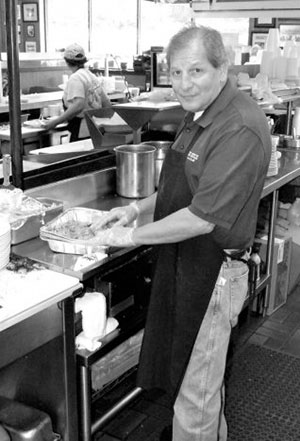
When Michael Matsos purchased Golden Rule Bar-B-Q, he hired Sammy Derzis to work as the restaurant’s manager. Derzis now owns a share of the business. Author’s collection.
Born in Birmingham’s Norwood neighborhood, Derzis has Greek ancestry and has worked in the restaurant industry since his youth. His maternal and paternal grandparents came from Sparta, Greece, and immigrated to the United States. His mother, Kay, came from Chicago. His father, Gregory, worked in the restaurant industry as a partner in two restaurants: Knotty Pine and Jeb’s Seafood House.125 At these restaurants, Derzis got his start cleaning floors and busing tables. “When you got old enough to go to work, you went to work,” explained Derzis, in the matter-of-fact way that people of Greek descent approach their work.
After attending Jacksonville State University, Derzis joined the navy and traveled around the world. From 1968 to 1972, he visited Cuba and the Mediterranean on the destroyer USS Allen M. Sumner. After a brief stint working for the Social Security Administration, he left government work and found a home in the restaurant industry. He simply stated, “I was tired of government work.”
Upon quitting government work, Derzis went to work at Joe Namath’s Restaurant before joining the team at Golden Rule Bar-B-Q. In its heyday, Joe Namath’s Restaurant attracted top musical acts, such as B.B. King, Fats Domino, Jerry Lee Lewis and other performers. “They needed a bartender, so I became their bar manager,” explained Derzis.126 At Joe Namath’s Restaurant, Derzis met cook Michael Booker.

For about four decades, Michael Booker has worked as the pit master at Golden Rule Bar-B-Q in Irondale. Author’s collection.
Born in Evergreen, Alabama, Booker attended Ramsay High School in Birmingham. As a high school student, Booker cooked steaks at Joe Namath’s Restaurant. After graduation, he joined the army and served eight years as a cook in Germany. “I kept in touch with Sammy when I was in the military,” explained Booker.127
When Golden Rule Bar-B-Q needed a new pit man, Derzis reached out to Booker. After Booker joined the staff, he learned how to cook barbecue from Pancho Simms, one of the pit masters who had worked for the Williams family and continued to work there after the restaurant changed ownership. “He took the time with me because he saw that I wanted to learn.…It was a different experience than cooking steaks,” explained Booker, who had to transition to cooking pork.128
Although Golden Rule Bar-B-Q has expanded across the state, the management and staff still view the restaurant as a family. In fact, Simms’s cousin Deborah also worked at the restaurant as an expeditor, keeping cooks and wait staff on the same page and ensuring food moves from the kitchen to the tables in a timely manner. At Golden Rule Bar-B-Q, Booker met Deborah, and they hit it off, married and started a family. “These are some great people to work for,” he said. “I go to their homes on holidays, and that means a lot.”129
The New Golden Rule Bar-B-Q
Once a small restaurant on a dirt road, Golden Rule Bar-B-Q has become regionally famous and recognized as one of the oldest operating restaurants in America. Under the ownership of Stevens and Matsos, Golden Rule Bar-B-Q has expanded in terms of menu offerings and locations.
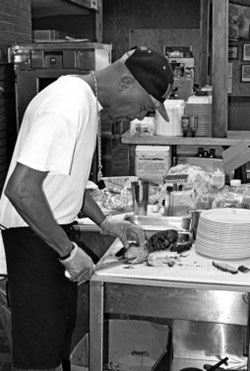
The cooks at Golden Rule Bar-B-Q prepare custom-made sandwiches. They will mix inside and outside meat to your preference. Author’s collection.
In the mid-1970s, Matsos and Stevens relocated the site of the restaurant and changed its atmosphere. They moved the restaurant to its current location just off I-20. Matsos explained, “I was lucky enough to get the piece of property right across the street from the exit.”130 In the new location, the management wanted a different vibe. “We wanted to present more of a family atmosphere,” explained Derzis, commenting on the decision made by the owners. The management of Golden Rule Bar-B-Q moved away from alcoholic beverages and put more emphasis on food.131 Over the last thirty to forty years, many barbecue restaurateurs who also owned restaurants on major highways between large cities made the same decision to focus on food.
With a renewed emphasis on quality food, Matsos believed strongly in keeping the kitchen area in the center of the restaurant, just like it had been at the old location. Matsos explained, “One of the things I kept up was having the pit in the dining room, where the customers see that it’s fresh—that there’s nothing hidden in the back.” They do all the cooking and carving in the center of the restaurant, where every customer can watch. “The only thing in the back of the house is the dishwashing machine and maybe some prep area of getting things ready,” boasted Matsos.132
In the early hours of the morning, employees put the pork shoulders in a smoker. At daybreak, Booker comes to work and removes the meat from the smoker and finishes it on a pit. Matsos explained, “We start it in the smoker because with the smoker you sort of are cooking from the inside out.” This way, the meat reaches perfect doneness.133
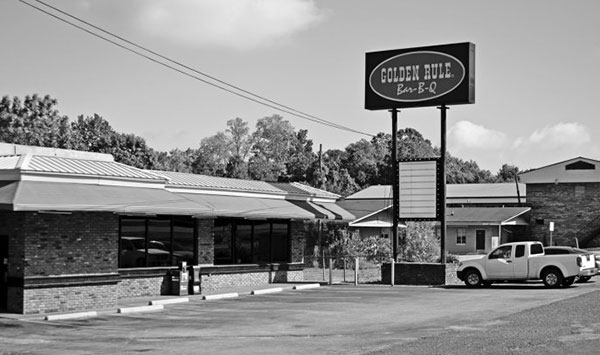
When Michael Matsos took over the restaurant, he moved it to this location off I-20. Author’s collection.
Then, the cooks carve each sandwich to order. Matsos boasted, “We make a custom-made sandwich.” They prepare each sandwich with sliced or chopped inside meat, outside meat or a mixture, according to customers’ wishes. “We have customers that are more or less spoiled,” remarked Matsos.
When the sandwich arrives on the plate, it has many things in common with other pork sandwiches in the Birmingham area: a red, tomato-based sauce and sliced pickles. Matsos explained, “Our sauce is the main thing, too, because ours is a tomato-based sauce, and people like it in this area.”134
Over the years, the new ownership team made many changes to the menu. Golden Rule Bar-B-Q now sells barbecue chickens, loin back ribs, turkey sandwiches, beef brisket, baked beans, French fries, potato salad, barbecue salads, green beans and more. In addition to these various offerings, Golden Rule Bar-B sells fresh pies, such as lemon icebox and coconut, and banana pudding.135
The Next Generation
In 2009, the Matsos family sold ownership of Golden Rule Bar-B-Q to Jeff Miller. At the time, Miller owned hundreds of Lee’s and Mrs. Winner’s chicken restaurants. As part of the deal, the Matsos family had franchisee ownership of four Golden Rule Bar-B-Q locations, including the one in Irondale.
In 2012, Michael Matsos passed away. By the time he had reached the age of ninety-three, Matsos had served celebrities like Bob Hope and Charles Barkley at his numerous restaurants throughout the city and state. “He constantly amazed me with his business sense and leadership ability,” explained Derzis, who also described Matsos as an expert deal-maker.136
Despite Matsos’s death, Golden Rule Bar-B-Q continues to have a strong influence from the past. Every day, Booker and Derzis work at the Irondale location. Together, they have more than seventy years of experience in the barbecue industry. The Matsos family, led by Michael’s son Charles and daughter Michele, continue to own Golden Rule Bar-B-Q restaurants.137
BIG BOB GIBSON BAR-B-Q
The Origins of Big Bob Gibson
In the early 1920s, railroad worker Bob Gibson began a side business selling barbecue on the weekends from his backyard off Danville Road in Decatur. Gibson, who stood six feet four inches tall and weighed more than three hundred pounds, was popularly known by the nickname “Big Bob.” “He still was working for the railroad when he started barbecuing and kind of did that as a past-time in the backyard, but people seemed to like his food so well he decided to quit the railroad business,” explained Gibson’s grandson Don McLemore, who continues to help run the business.138
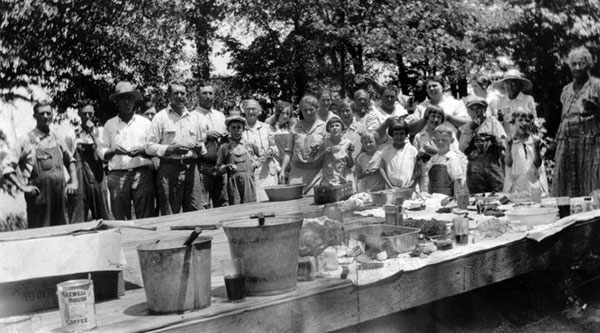
The Gibson family poses with the barbecue in Big Bob Gibson’s backyard at his home off Danville Road in Decatur. Chris Lilly.

Catherine McLemore, a daughter of Big Bob Gibson, poses with her son, Don, outside their home off Danville Road in Decatur, Alabama. Big Bob Gibson got his start cooking barbecue in the backyard of this home. Chris Lilly.
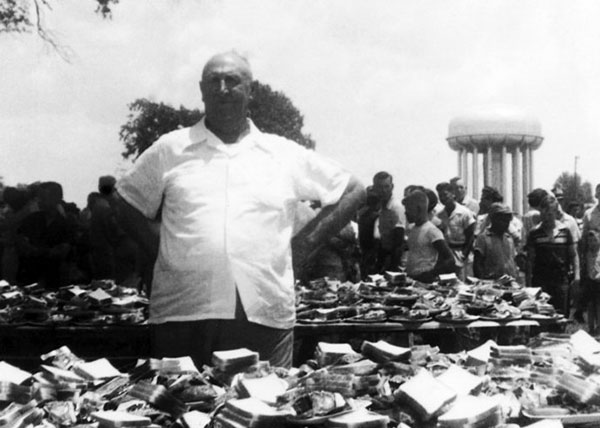
Big Bob Gibson poses with his barbecue and white bread at a park in Decatur. Chris Lilly.
After leaving his job on the railroad, Gibson cooperated with his brother-in-law, Sam Woodall, to open a restaurant on Moulton Road in Decatur called Gib-All’s. Woodall left the partnership to join his brother in business, and Gibson continued the operation under the now-famous name Big Bob Gibson Bar-B-Q. Gibson relocated his restaurant numerous times in the 1920s and 1930s. McLemore described the early restaurants as places where “you might stand up and place an order and might have a few chairs or stools or something.”139
As the business grew, it became a family endeavor. On the subject of family, McLemore recalled, “They all had an interest in the barbecue business. They all did go in the barbecue business, and that’s how they made their living—all of them.”140 Gibson’s restaurant rose from these humble origins to gain regional and national recognition due to his original white sauce recipe.
The Invention of White Sauce
Gibson crafted a vinegar-based white sauce to smother his smoked chickens. He split his chickens, seasoned them, roasted them over hickory smoke for three hours and then dunked them in the mayonnaise, vinegar and black pepper concoction. “I guess the thing he’s more well known for than anything in the barbecue world is his white sauce,” explained McLemore in reference to his grandfather.
Although the sauce was originally intended for chickens, customers now pour it on everything. “They will try it on pork, or some even try it on ribs,” explained McLemore. He added, “It’s very good on potato chips. A lot of kids do that. I’m not a kid, but I still do it once in a while myself.”141
Due to the success of the white sauce, it has become a staple of barbecue restaurants across the state. “What makes me feel good is when you go to some of the better-known restaurants in Alabama now, and you see that they have a bottle of white sauce,” said McLemore. His son-in-law, Chris Lilly, also recognizes the importance of white sauce to the state’s barbecue scene. “We’re most noted for our barbecue chicken with white sauce because it’s an original recipe,” boasted Lilly. “It’s cool to know that there’s a regional sauce that gets a lot of publicity, and it started here.”142
The Next Generations
In 1952, Big Bob relocated the restaurant to an existing building on Sixth Avenue in Decatur, but he also turned the business over to his daughter. Catherine McLemore offered to take over the day-to-day operations of the restaurant in exchange for half the business. Don characterized his grandfather as an outdoors person. “He liked to fish; he liked to hunt,” he explained. As part of the deal, therefore, Catherine let her father work as much or as little as he wanted. Don recalled, “He jumped right on it.” With a desire to fish more and relax, Big Bob accepted his daughter’s offer. Now, Big Bob could spend his time as he pleased.143
At the same time, they started selling their mouthwatering coconut cream, lemon icebox and chocolate cream pies. Maddie Johnson, who had started working at Big Bob Gibson’s Bar-B-Q in the 1940s, made the pies when Catherine added them to the menu. She continued to make pie for five decades. According to current owner Chris Lilly, “At Big Bob Gibson’s, the pie makers open the restaurant. They get here before the pit guys.” Recently, they have added pecan and peanut butter pies.
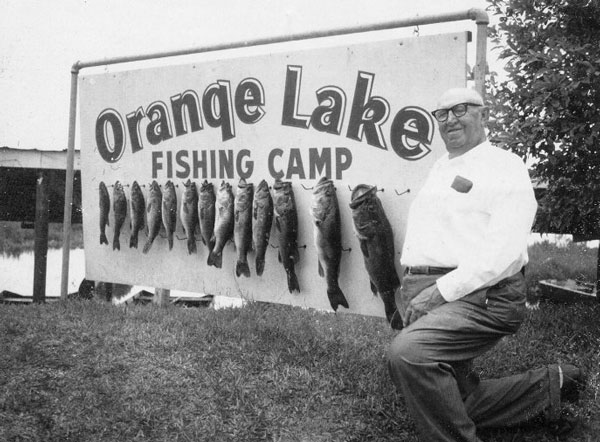
At Orange Lake near Gainesville, Florida, Big Bob Gibson shows off his catch. Chris Lilly.
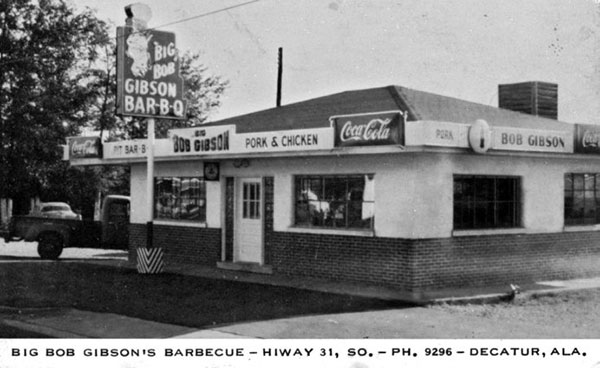
In 1952, Big Bob Gibson opened this location of his restaurant on Highway 31 in Decatur. It remained in operation until 1987. At that time, the family constructed their own building on the adjacent property. Chris Lilly.
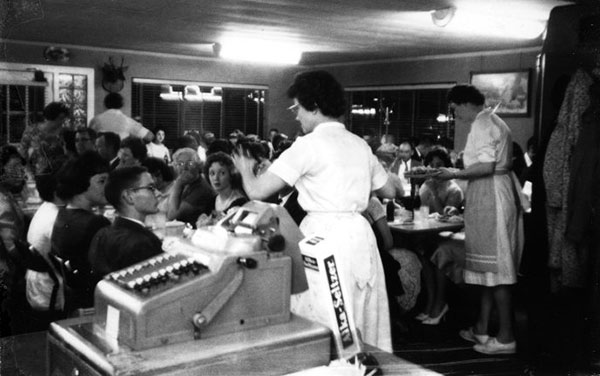
Inside the Highway 31 location of Big Bob Gibson Bar-B-Q in Decatur, a waitress serves a packed house. Chris Lilly.
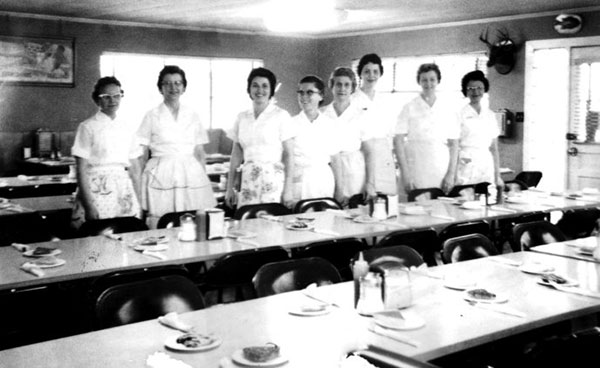
On the far right, Maddie Johnson poses with the rest of the Big Bob Gibson Bar-B-Q staff. In 1947, Johnson started working for Big Bob Gibson Bar-B-Q and remained employed there for many decades. Chris Lilly.
After Gibson’s death in 1972, his five grandchildren, including Don, and their spouses took over the business. Under new ownership, Big Bob Gibson Bar-B-Q relocated one more time and opened a second location. In 1987, they built a larger restaurant on Sixth Avenue because their previous landlords refused to allow them to remodel and expand the existing structure. In 1992, they opened a restaurant on Danville Road. These two locations remain open for business.
They also modernized the facilities. Originally, Big Bob smoked the meat, which he purchased from local farmers, in an “old-fashioned concrete block pit.” His family has since modernized their methods for the sake of commercial feasibility and safety, but Don insisted, “we come as close as we can” to cooking meat in that traditional manner. “We still have the old-fashioned brick pits—not concrete blocks but brick and firebrick. We have a flat grate and we have a big fire up in the front of the pit, and we cook with indirect heat and smoke.”144
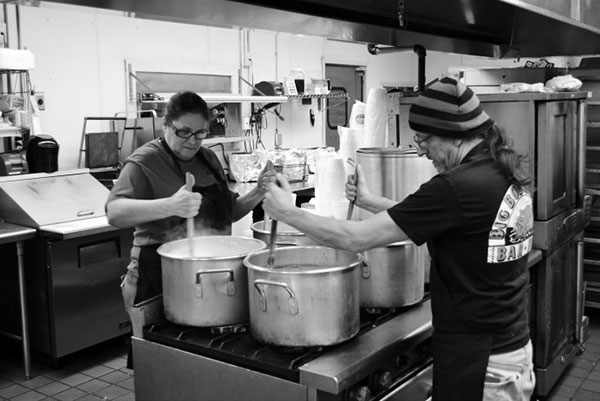
Before the restaurant opens, Diane Wilhite and D make pies every day for the large crowds who pack Big Bob Gibson Bar-B-Q. Author’s collection.
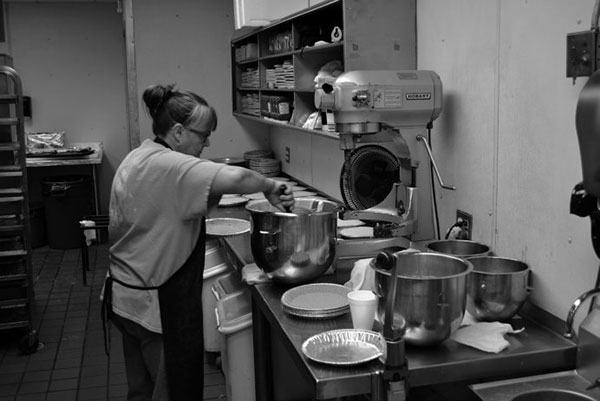
Like the other pie makers at Big Bob Gibson Bar-B-Q, Joanne Gunner arrives to work before anyone else to make fresh pies for the restaurant. Author’s collection.

Big Bob Gibson Bar-B-Q offers numerous types of pie, including this coconut cream pie. Chris Lilly.
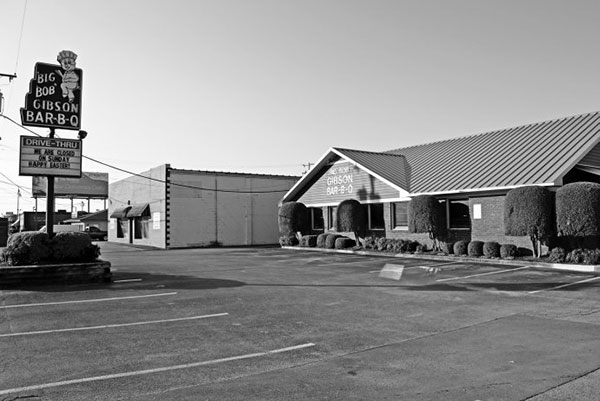
Before Big Bob Gibson Bar-B-Q opens, only the cooks and pie makers have arrived at the restaurant. Author’s collection.

After the lunch crowd, Big Bob Gibson Bar-B-Q sits quiet before the evening rush hits. Author’s collection.
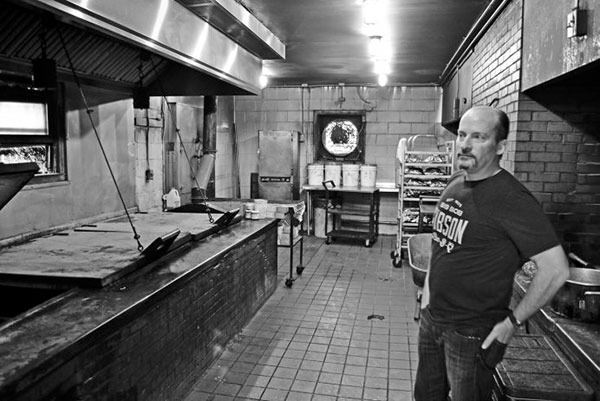
Chris Lilly, of Big Bob Gibson Bar-B-Q, surveys the pit room during a quiet part of the day. Author’s collection.
When Gibson opened his first restaurant, he served pork shoulders, chickens, coleslaw and potato chips, but the menu has continued to expand over the last few decades. In the late 1980s, the menu has expanded to meats like beef brisket and turkey, ribs and more modern dishes like barbecue-stuffed potatoes and barbecue-topped salads, served to an increasingly national and transient audience. “We were the first barbecue restaurant in Alabama, to my knowledge, that started selling the barbecue potato and, at the time, they were cheap to buy because we used the real big potatoes,” explained McLemore. These baked potatoes, stuffed with butter, sour cream, chives, bacon, cheese and a choice of barbecued chicken, turkey, pulled pork or beef brisket, soon became a hit throughout the state. McLemore boasted, “Now you can’t hardly go to a restaurant in Alabama and not get a barbecue potato.”145
They cook pork shoulders and beef brisket all night long and carve each sandwich and plate to order. They cook whole pork shoulders, which includes the picnic and the pork butt, for seventeen hours overnight. Big Bob only rubbed his pork shoulders with salt, but they now use a blended dry rub. According to Lilly, “We carve to order, one shoulder at a time.” They avoid chopping it ahead of time in order to retain the juices. “If you chop it ahead of time and try to hold it, you need to add a lot of sauces to keep it moist,” said Lilly, who now helps run the restaurant.146
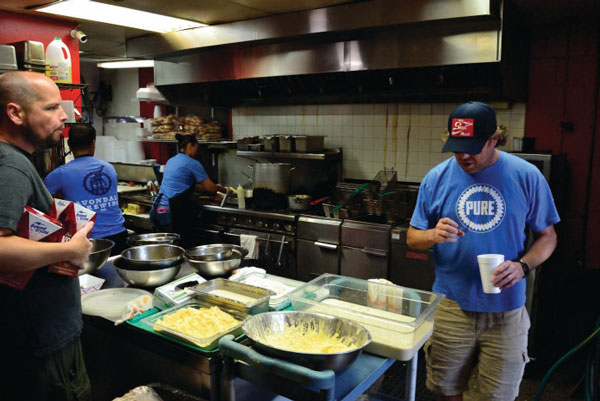
Mike Wilson, who founded the Saw’s family of restaurants, supervises the staff and tastes the product at his Avondale location, Saw’s Soul Kitchen. Author’s collection.

At Big Bob Gibson Bar-B-Q, a pulled pork sandwich comes topped with vinegar-based coleslaw. Chris Lilly.
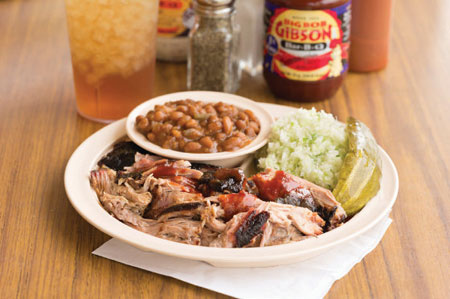
The cooks at Big Bob Gibson Bar-B-Q pull the pork shoulders to order to maintain moisture. Chris Lilly.
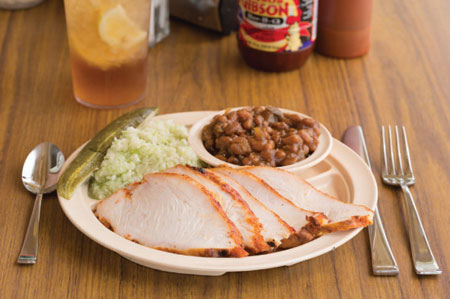
Big Bob Gibson Bar-B-Q serves turkey platters with two sides and a pickle. Like all their dishes, it does not come with sauce because they want to leave that option to the customer. Chris Lilly.
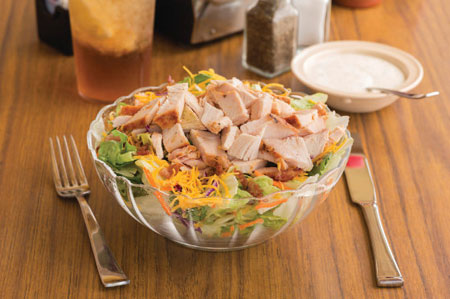
Big Bob Gibson Bar-B-Q serves its turkey on a salad for the healthconscious customer. Chris Lilly.
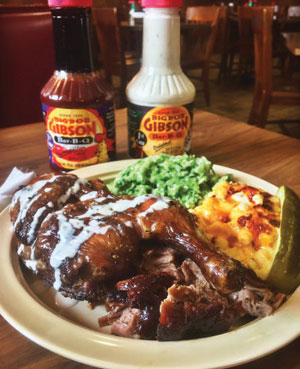
This Big Bob Gibson Bar-B-Q combination platter features pulled pork and smoked chicken, which has been drizzled with white sauce. The sauce, which Big Bob Gibson invented, consists of mayonnaise, vinegar and black pepper. Ken Hess.

In addition to their famous smoked chicken and white sauce, Big Bob Gibson offers pork ribs, among other items. Ken Hess.

At Big Bob Gibson Bar-B-Q, customers can order beef brisket as well as the pork and chicken that typically feature on the menus of Alabama barbecue restaurants. Ken Hess.

Big Bob Gibson Bar-B-Q makes pie every single day, including this chocolate cream pie. Chris Lilly.
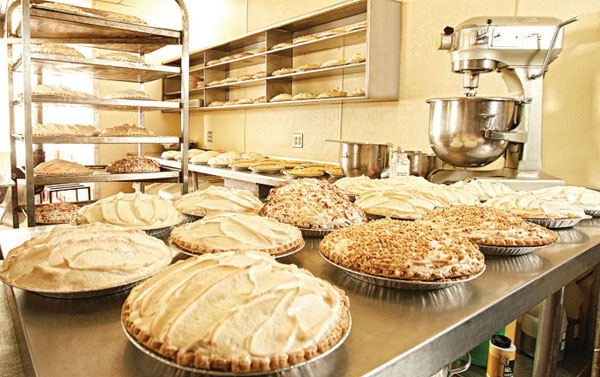
Every morning, the pie makers open Big Bob Gibson Bar-B-Q to make fresh pie for the day. Chris Lilly.
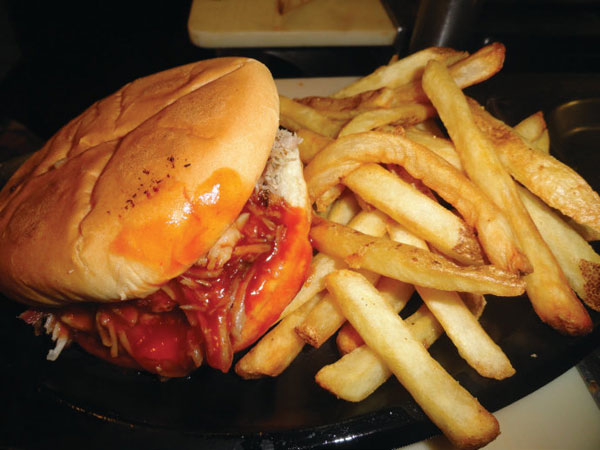
Bob Sykes Bar-B-Q offers customers many choices, including this BarBQ Pork Sandwich. Elaine Lyda.
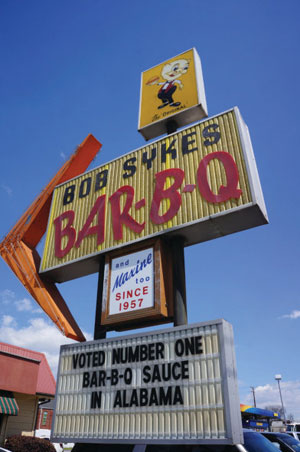
For six decades, Bob, Maxine and Van Sykes have been working in the restaurant industry. Elaine Lyda.
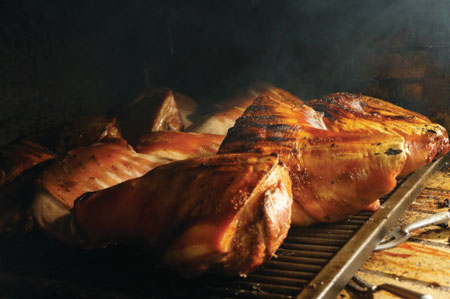
Bob Sykes Bar-B-Q slow cooks pork butts over an open pit. Elaine Lyda.

Among many sides, Bob Sykes Bar-B-Q offers onion rings. Elaine Lyda.
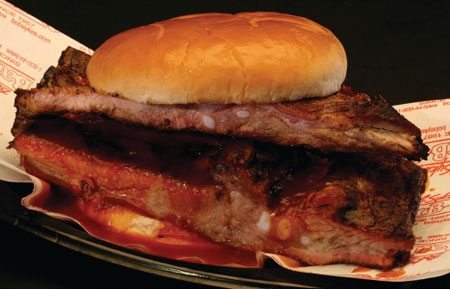
In addition to pork sandwiches, Bob Sykes Bar-B-Q offers rib sandwiches. Elaine Lyda.

John “Big Daddy” Bishop proudly serves his famous ribs. For a long time, he only served them with white bread. Dreamland Bar-B-Que.
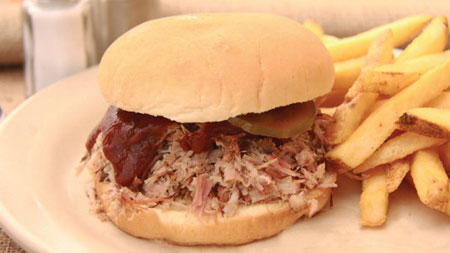
At Demetri’s BBQ, the pork sandwich is the bestseller. Sam Nakos.

Unlike barbecue restaurants in the northern part of the state, Demetri’s BBQ serves its chicken with red, tomato-based sauce. Sam Nakos.
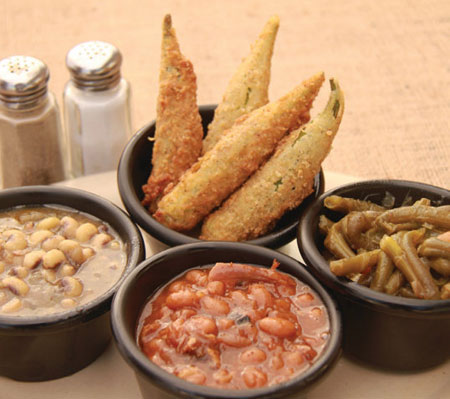
To complement a diverse menu, Demetri’s BBQ has many sides, including green beans, baked beans and fried okra. Sam Nakos.

At Golden Rule Bar-B-Q in Irondale, pork slowly cooks over an open pit. Author’s collection.

Originally, Dreamland Bar-B-Que only sold ribs and white bread. Now, they have pulled pork, sausages and more. Dreamland Bar-B-Que.

When John “Big Daddy” Bishop opened the restaurant, he did not have pork sandwiches or side items. As the restaurant expanded, they needed more options to reach a wider audience. Dreamland Bar-B-Que.
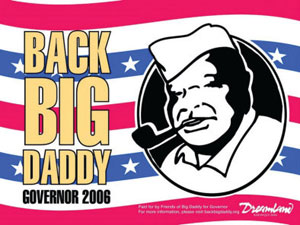
In 2006, Dreamland Bar-B-Que ran a campaign to posthumously elect John “Big Daddy” Bishop as governor. He ran on the platform of the Dinner Party. Long before barbecue dominated the restaurant scene, Alabamians used barbecue to practice their politics. Today, barbecue remains fundamental to politics. Before the 2016 presidential election, candidate John Kasich visited Dreamland Bar-B-Que in Birmingham. Dreamland Bar-B-Que.

Dreamland Bar-B-Que serves world-famous ribs with their famous sauce. Dreamland Bar-B-Que.

At Moe’s Original BBQ, they do more than barbecue. They serve catfish and shrimp po’ boys, as well. Mike Fernandez.

Moe’s Original BBQ serves their chickens and turkeys with white sauce. Mike Fernandez.

Moe’s founders Ben Gilbert, Mike Fernandez and Jeff Kennedy all come from Alabama, but they started their first restaurant in Vail, Colorado. Mike Fernandez.
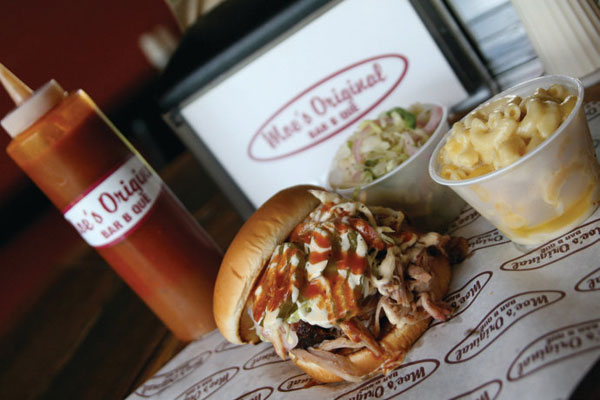
The smoked chicken sandwich comes topped with coleslaw. Mike Fernandez.

At Moe’s Original BBQ, the rib platter comes with sides and a drink. Mike Fernandez.
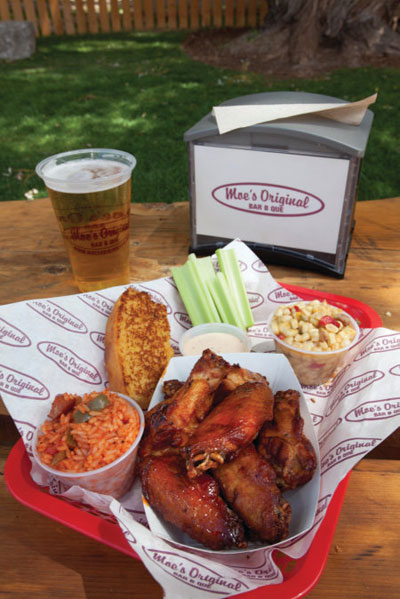
The smoked wings platter comes with white sauce and side items. Mike Fernandez.

Libby Fernandez developed the coleslaw recipe that tops this turkey sandwich. Mike Fernandez.
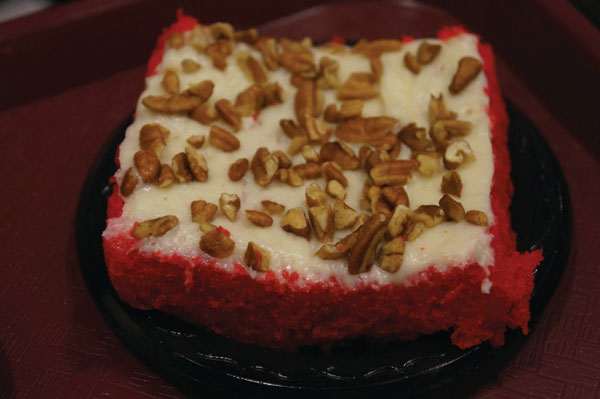
In recent years, Bob Sykes Bar-B-Q has expanded its dessert menu to include cakes. Elaine Lyda.

Bob Sykes Bar-B-Q bottles and sells its original sauce. Many of Alabama’s barbecue restaurants aspire to sell their own sauce across the state and the country. Elaine Lyda.
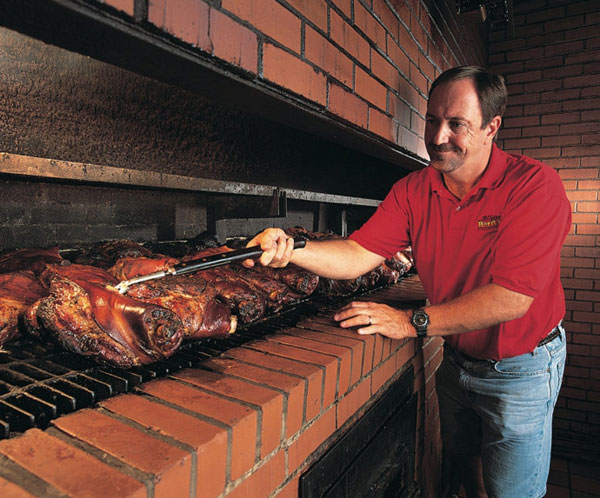
In Bessemer, Van Sykes tends the pit at Bob Sykes Bar-B-Q. Elaine Lyda.
In the morning, they start cooking chicken, ribs and turkey. They procure all of their American-raised meat from purveyors in Birmingham, Huntsville and just across the border in Tennessee. “I think you are doing yourself a great disservice if you limit yourself to one meat supplier,” explained Lilly. Before ordering, he surveys the meat for price, color and marbelization to make the best choice.
Big Bob Gibson Bar-B-Q Ribs
Cooking Method: indirect heat
Suggested Wood: hickory
Cook time: 4 hours
2 slabs St. Louis cut pork spare ribs
Dry Rub
2 tablespoons brown sugar
1 tablespoon paprika
1½ teaspoons kosher salt
1 teaspoon black pepper
½ teaspoon garlic salt
½ teaspoon onion salt
¼ teaspoon celery salt
½ teaspoon red pepper
½ teaspoon ground cumin
1 bottle Big Bob Gibson Championship Red Sauce
Remove the membrane from the back of the rib. In a small bowl, combine the dry rub ingredients and mix well. Apply generously to the front and back of ribs, patting gently to ensure the rub adheres.
Build a fire (wood or combination of charcoal and wood) for indirect cooking by situating the coals on only one side of the grill, leaving the other side void. Preheat charcoal cooker to 250 degrees Fahrenheit. Place the ribs on the grill meat side up and cook with indirect heat for 3 hours 45 minutes or until the ribs are tender.
Remove ribs from cooker and paint with Big Bob Gibson Championship Red Sauce. Put the ribs back on the cooker over indirect heat and cook until the sauce caramelizes, 10 to 15 minutes. Remove the ribs from the grill and let them rest for 10 minutes before serving.
Like other Alabama barbecue restaurants, Big Bob Gibson Bar-B-Q uses hickory wood to build its fires. According to Lilly, “The most important aspect of wood is how long it’s seasoned. It’s more important than the variety of wood. When you get a nice seasoned wood, you get a mellow smoke and a great smoky flavor.” The seasoning process consists of drying the wood to the desired moisture content. At Big Bob Gibson Bar-B-Q, they use hickory wood that has been seasoned for four to six months.147
Over the years, Big Bob Gibson Bar-B-Q has left an impression on more than just the Alabama barbecue scene. Recently, it has attained international fame because of the success of Chris Lilly at international barbecue cook-offs.
Chris Lilly Joins the Family Business
Born in 1968 in Florence, Chris Lilly learned to appreciate food, especially barbecue, from his parents, but he never envisioned becoming the owner of a barbecue restaurant and world champion pit master. “My family sat down for dinner every night and ate as a family. I had a good hot meal every night and enjoyed food,” recalled Chris.148
Like most Alabamians, Chris fondly remembers his father, Owen Lilly Jr., cooking barbecue in the backyard. Whenever his father cooked outside, he wanted to help. As a child, Chris experimented with marinades and seasonings. “Growing up, cooking is something I always liked to do, but I never thought it would turn into a profession.” He admitted, “I never dreamed I would be in the barbecue business.”149
In addition to backyard cooking, Owen took his large family to some of Alabama’s famous barbecue restaurants. “My dad loved barbecue. I still remember going around to the barbecue restaurants with the old pit masters shoveling coals under the pit,” Chris recalled. Growing up in Florence, Chris enjoyed pork sandwiches at locally famous Bunyan’s Bar-B-Que, located on West College Street not far from McFarland Park on the Tennessee River, and Dick Howell’s Barbeque Pit, which remains in the same cinderblock restaurant that Chris’s father helped build.150
Owen, who grew up in Memphis and studied architecture at Georgia Tech in Atlanta, had fond memories of Big Bob. To get to Atlanta from Memphis, Owen traveled through Decatur and would stop and eat at Big Bob Gibson Bar-B-Q. By this time, Gibson had a full-service restaurant. Chris explains, “My father remembered seeing Big Bob behind the counter handing out bubblegum to the kids and putting on a big show.” Many years later, Chris met Big Bob’s great-granddaughter Amy McLemore.151
From 1986 to 1990, Chris studied marketing and finance at the University of North Alabama, where he met Amy. On September 1, 1990, Amy and Chris married, which brought Chris into the family business. Lilly says, “I was very fortunate. When I got into the barbecue business, I started with what I thought was the best barbecue. Big Bob Gibson’s Bar-B-Q already had a great history and a fantastic reputation in this area.” Lilly adds, “I think one of the best things I have done is take that reputation and let everybody know about it. Now, Big Bob Gibson’s Bar-B-Q is known around the world.” Lilly appreciates the restaurant’s global recognition. “When you look at the license plates, you see so many different license plates from outside of Alabama. These are people who have come to eat here.”152 Lilly has helped spread the reputation of Big Bob Gibson Bar-B-Q through his team’s success at barbecue competitions.153
The Competition Scene
After joining the restaurant, Lilly has helped Big Bob Gibson Bar-B-Q achieve international fame by leading his crew to victory at numerous international barbecue competitions. Barbecue competitions come in many different formats. They all have rules concerning team composition, fuel source, the use of electronics and recipe restrictions. In Kansas City Barbeque Society competitions, teams submit samples to judges in four categories: chicken, pork ribs, pork and beef brisket.154
For more than forty years, the Memphis in May World Championship Barbecue Cooking Contest has attracted the best competitors from around the world. At Memphis in May, Lilly has led the Big Bob Gibson team to numerous titles. They have won the grand championship at this famous competition four times: 2000, 2003, 2011 and 2014. In addition to these grand championship titles, they have also won eight times in the pork shoulder category: 1999, 2000, 2001, 2002, 2003, 2004, 2011 and 2014.155
Due to competition success, Lilly has changed some of the recipes at Big Bob Gibson Bar-B-Q. “We have used the competitions as marketing research for our restaurant,” explained Lilly. Before the competition scene, they only used salt, black pepper and cayenne pepper. Now, they have unique dry rubs for each of their meats. Lilly explains, “All of those recipes were born through competition.” They do not change the recipe at the restaurant solely because of competition success. Lilly tests these recipes with loyal customers. He explained, “We have a lot of regular customers who have eaten here their entire lives.” He added, “We wanted their blessing before we rolled it out in the restaurant.”156

In 2000, Don McLemore, Chris Lilly and the rest of the Big Bob Gibson crew first won grand champion at Memphis in May International Festival. Chris Lilly.
They have also added a new sauce because of its success at barbecue competitions. Big Bob Gibson’s Bar-B-Q still offers the original white sauce recipe crafted by Big Bob. For years, they also had a traditional sweet red barbecue sauce. They bought it on the market and bottled it. “I never liked it; Don never liked it,” explained Lilly. When they started doing competitions, they wanted to formulate their own sauce. Don and Chris exchanged recipes and ideas over and over again. According to Lilly, “We traded it back and forth for a year and half.” In 1997, their wives had grown tired of the guys messing up the kitchens at home, and McLemore and Lilly decided to finish the recipe. They mixed their two best recipes, entered it into the sauce contest at Memphis in May and won. Now, they serve the sauce in their restaurant.
The Future
Chris and Amy now have three children: Jacob, Andrew and Caroline. The two boys have already started in the family business. Jacob and Andrew both graduated from the University of Alabama, and they help their father run Big Bob Gibson Bar-B-Q. After working for a year elsewhere, Jacob returned to Decatur and started working at the restaurant’s location on Sixth Avenue. Andrew returned to Decatur immediately and works at the Danville Road location. “I started them where I started: in the pit room. You have to learn the pit room and how to cook everything before you can learn the rest of the restaurant,” explained Lilly.157

Jacob Lilly, like his father before him, learns to master the pit before taking on any other responsibilities. Jacob, who graduated from the University of Alabama, represents the fifth generation of the family to work at Big Bob Gibson Bar-B-Q. Author’s collection.
The team at Big Bob Gibson expresses enormous respect for barbecue restaurateurs in the state of Alabama. “I have a lot of respect for the familyowned restaurants who have been doing it decade after decade and pass the traditions down,” explained Lilly.158
Chris Lilly wants Alabama barbecue to become recognized for its barbecue success. He explains, “Often, I think Alabama has been overlooked. People shoehorn barbecue into four regions: Kansas City, Carolina, Memphis, and Texas.…I think we’ve helped push Alabama barbecue to the forefront.”159